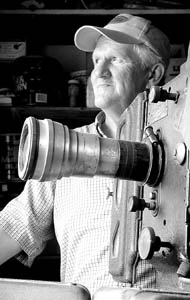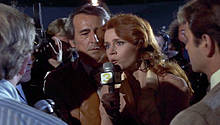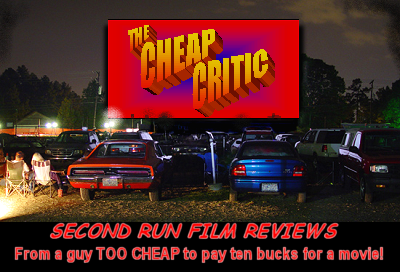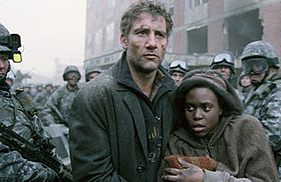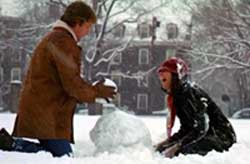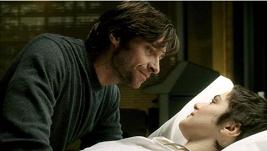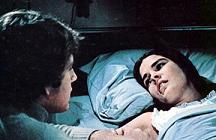I must admit that I find the video fascinating. I've watched it dozens of times and I'd like to thank Wrechard for bringing it to my attention and, of course, I'd like to thank Al Qaeda in Iraq for the intriguing puzzle they have given me. And, a final thanks is due to Iraq Slogger for starting the process by posting a link to the video.
Assuming you have the right MacroMedia plugin installed the video should be below. [This should be safe enough for 'sensitive' viewers -- there is no gore or clear suggestion that anything but hardware is damaged -- but you might want to turn your sound down, depending on where you stand on repetitive, annoying martial music sung in Arabic.]
One of the buttons at the bottom of the video player should launch a larger version of the video where you can see things a bit more clearly. (But that's only a bit more clearly; the video quality is only so-so at best and, as I will argue, parts of the images are deliberately obscured.) [if you have trouble getting the video to play try this link.]
Description of the video
The video consists of three segments. The first seqment runs from time 00:00 to 03:20 and is, or appears to be, one continuous take of an insurgent sneaking up on a parked Bradley, placing a bag under it (presumably containing explosives) and also positioning a fuel can beside the explosives. At one point the camera zooms out to a wide-angle shot and a red circle appears on the left to highlight an area, presumably indicating the location of coalition troops, most likely the Bradley crew (all that is actually visible is a palm tree, a bit of wall with an arched window and a vertical feature that might be a soldier.) The camera is mounted on a tripod with the head free to tilt and pan. The operator zooms in and out and pans to follow the stealthy activities of the bomb planter. The presence of a tripod is revealed by the consistent six-degree cant to the camera. At the end of the first segment the operator zooms and pans to a particular view and then locks the tripod head. There is an obvious dissolve to segment two.
The second segment (03:21 to 04:22) is shot with a stable, unmoving camera. It shows a few seconds leading up to the primary explosion (which is looped to repeat four times) and a subsequent smaller explosion that ignites a fire. Before the explosion, in parts of the image (such as the palm tree on our left) there is considerable motion but in other parts there is no movement at all. The white flag on the right side that was fluttering briskly in the wind now hangs limp, contrasting oddly with the palm tree fluttering in the wind on the left. A head pops up behind the Jersey barrier on our left, moves a few steps towards the explosion, pauses and then moves rapidly away and out of frame to our left. Various commenters have identified the figure as a man giving hand-signals and a dog. The explosion itself happens so quickly that the Bradley is obscured in less than a single video frame. That is, there is no frame that shows the Bradley after the explosion -- it literally disappears in a puff of smoke. At no point in this segment after the explosion do we see the effects of the explosion on the vehicle. During the explosion there is also something odd going on in the foreground (in the puddle near the end of the Jersey barrier.) It appears to be the reflection of a bird that flew though an area that has been removed. The bird (if that's what it is) does finally appear, flying up towards the explosion and then back down and disappearing at the edge of the Jersey barrier. It's not clear if the bird(?) went behind the barrier or just disappeared when it reached the edge of the barrier. The bird(?) is easiest to see right after the fourth (and final) showing of the explosion which seems to be even more slow-motion than the first three. The slow motion continues until 03:45 then a more normal speed resumes with seconds 03:45 and 03:47 repeating what we saw in 03:40-03:45, only faster. The second sequence ends with another dissolve to the same scene with something shaped more-or-less like a Bradley visibly burning with lots of thick black smoke.
The third segment (04:23 - 05:02) shows the Bradley (? pile of tires? whatever...) burning in the middle of the street with lots of billowing black smoke. The center part of the image is quite sharp and contrasty but parts of the left and right are oddly blurred. The wall on our right and the Jersey barrier are quite unconvincing if you make a point to look at them instead of the flames and the smoke. We can see what appears to be the shadows of the billowing smoke flowing over the palms, sidewalk and utility poles on the right. The white flag mostly hangs oddly still with an occasional peculiar flap or two that seems to start and stop in mid-motion. The scene finally fades to the logo and animated flames that started the video.
Discussion of individual elements
Red Circle: Here's the red circle. I don't know for sure what we are supposed to see here. A G.I. standing on the porch by a window and a palm tree?
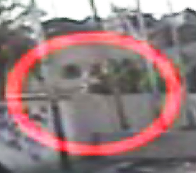
Size of the Bradley: One commenter on the Belmont Club was sure the video was altogether fake since the Bradley appears to be too big. Bearing in mind that a Bradley can easily drive under a ten-foot overhang, how short must the bomber be here?
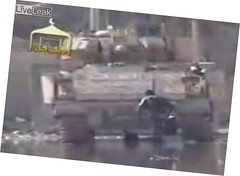
I've adjusted for the cant of the camera here.
Here is another shot of a Bradley from my archives. I happen to know that this young man is about 6'1". The low angle of this shot tends to make him look bigger and the vehicle smaller but it gives some sense of scale.
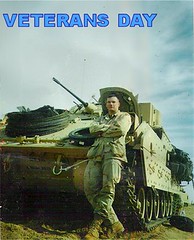
For myself, it seems possible that the bomber was that short. But I dunno. If really was a tiny little guy he must have been really strong, too, since he picks up that big fuel can as if it were empty.
The Tracks If you look closely at the tracks of the Bradley you will see that you can't see them. They have been deliberately blurred in each and every frame in which they appear -- especially the center of the track with its distinctive removable rubber shoes that limit road damage. Here is a detail:
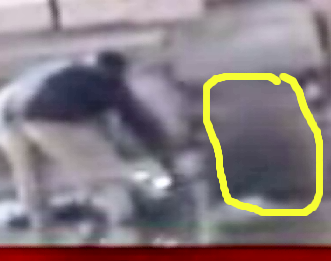
I'm not an expert on track configurations but I do know that the tracks on the Bradley have changed several times recently. As the Bradley was deployed into Iraq the Army kept adding additional armor which made them heavier -- which made the tracks wear out faster -- which was a pain in the neck. So the army modified the track to have larger, longer-wearing rubber shoes to improve maintenance intervals. It's possible that the tracks have been obscured to prevent identification of the vintage of the Bradley and it is also possible that the distinctive tracks have been obscured to hide the fact that what is shown is not a Bradley at all but some other tracked vehicle (possibly construction equipment) that has been disguised. Here is an example of what a Bradley track can look like:
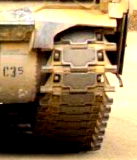
The White Flag: There are two elements in the video that indicate generally how windy it is. The palm tree that we saw in the red circle tosses in the wind throughout the video on the left side of the screen and there is a white flag on the right-hand side. The motion of the flag comes and goes making me suspect that some parts of the video are assembled from footage taken at different times. Look for times when the palm tree shows a windy day and the flag is just hanging there. Here's the flag so you'll know what to look for:
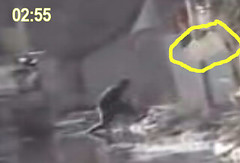
The Guy who Might Be a Dog: In segment two a head pops up behind the Jersey barrier on the left from time to time. Various commenters have identified it as a man and a dog. I tend to think it's a guy and that the odd trotting motion that makes him look doglike as he exits to the left after the explosion is an artifact of a reduced frame rate. If he is a man it is significant that he is trying to hide from the camera and not from the Bradley or the presumed location of the coalition troops. Here he is looking like a man:
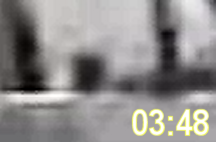
The Invisible Bird: In the four seconds before the explosion you can see the reflection of something moving from left to right in the puddle at the end of the Jersey barrier. It's only a few pixels and you have to be pretty compulsive to see it before the explosion. It is easier to see in the first frame or two after the explosion where it stands out against the relatively bright reflection of the dust. Here it is with an arrow pointing to it (you are looking for a dark spot):
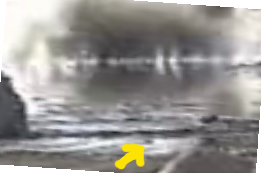
If you watch that area just after the explosion you can see something (the invisible bird?) that appears out of nowhere, launches itself up and to the left (towards the explosion) and then veers off towards the Jersey Barrier where it disappears. The best time to look for it is just after the fourth replay of the explosion (around 03:32). In the image below you can see a bit of a streak behind the bird and I've added a yellow line showing where it will go.
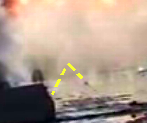
Shadows on Blurred Palms: The last segment, with the shadows of the smoke of the burning Bradley(?) flowing across the sidewalk and the palms on the right of the screen ties the burning vehicle to the location. Because of the angle of the light and the three-dimensional locations of walls, utility poles, vegetation, etc. it would be fairly difficult to simulate. On the other hand, if one were going to try to simulate it by, say, filming the shadow of clouds over several days and speeding them up one would need to obscure the details of any foliage that would move in the wind and look odd when sped up. The result might look something like this:
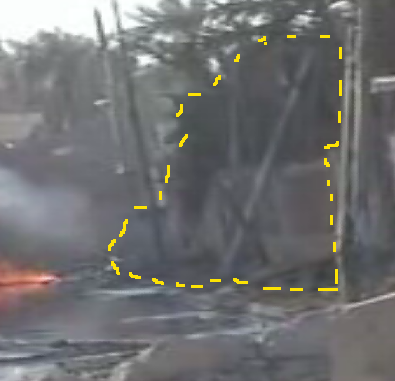
I added the yellow dotted outline but I did not blur the area inside of it. Compare the resolution of the flames with the vegetation inside the dotted outline.
S..L..O..W - M..O..T..I..O..N ?
Here is a screen grab from four seconds before the first instance of the explosion.

What struck me about the seconds leading up to the explosion is that there is a big chunk in the middle of the screen where nothing is happening. To our left the palm tree that was in the red circle is thrashing away in the wind and on the right the palm trees overhead are also moving. But near the bradley nothing is happening. It looks like a glass shot from an old movie -- a scene shot through painting on glass with openings for the live-action parts. In a glass shot the painting covers everything but a small area occupied by actors, props, sound-stages, etc.. Think Dorothy skipping up the Yellow Brick Road (sound stage) towards the Emerald City (painted on glass).
If you look closely at the area around the Bradly during those four seconds you might notice that it seems to lack the waver and flicker of low-quality compressed video. Video cameras tend to second guess themselves from frame to frame. A pixel that looked gray before will suddenly seem more tan. The compression algorithm ignores those changes up to a point but will return to the area later and redraw and catch up. This is what makes compressed video look like a reflection in the surface of simmering water -- just short of a boil. The area around the Bradley never appears to attract the attention of the redraw algorithm and never to get redrawn. Or so it seemed to me.
To test my theory I took five screen shots about one second apart (the shot above being the first og the five) and used my image editing program to highlight the pixels that had changed from one image to the next. The changes between the first two images are highlighted in red. Here's T-minus-four:
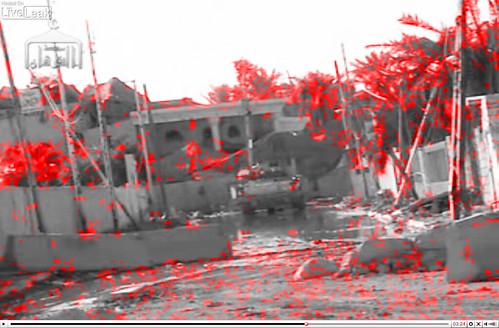
The red blob behind the Jersey Barrier on the left is Mr. Man-or-Dog popping his head up. We'll see him again at T-minus-one. Here is T-minus-three:
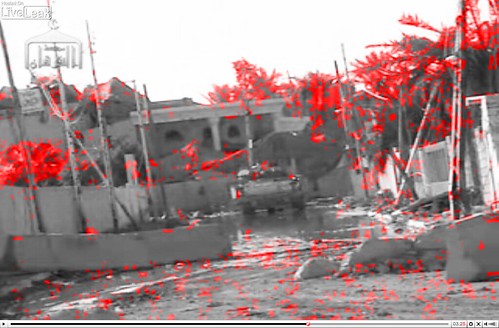
It's rather hard to see at this size but if you click on these images it should take you to a larger image where you can see the red marks from the moving shadow of the invisible bird. Here is T-minus-two:
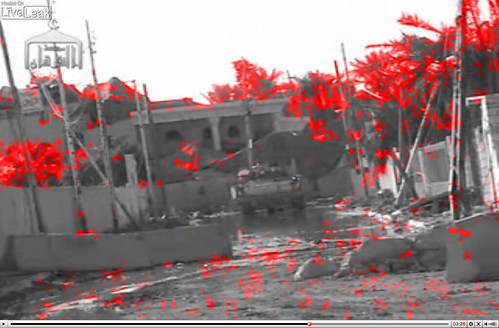
And here is T-minus-one (Mr. Man-or-dog makes another appearance):

Adding up all the red spots into a single image we get this:
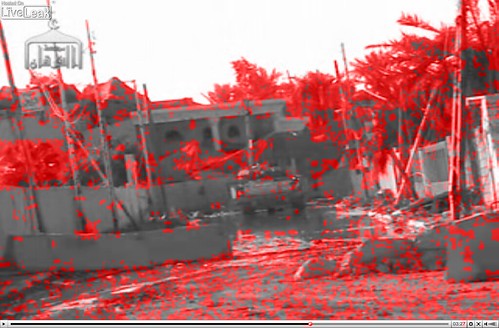
The palm tree moving in the wind is almost entirely red as one would expect but what is interesting is how square the red area around the palm tree appears. Also expected is the speckling of the foreground. An occasional pixel that is on the borderline between two colors will be one color in one frame and another color in the next. What seems odd are the areas where nothing changes -- especially areas (such as the undercarriage of the Bradley and the spot on the sidewalk on the right) where there does seem to be some detail (which would tempt the video compression algorithm to tinker) but nothing changes for four whole seconds.
I have drawn some rather arbitrary outlines around the parts of the picture where nothing much seems to change from second to second. My theory is that the images were assembled from footage shot at different times and played back at different frame rates. The palm tree, for instance, is clearly playing at more-or-less normal speed but the area under and just in front of the Bradley appears to be playing in slow motion. Parts of the right side of the image (where spectators might have been standing) seem to have been replaced with still images. Here are my outlines:
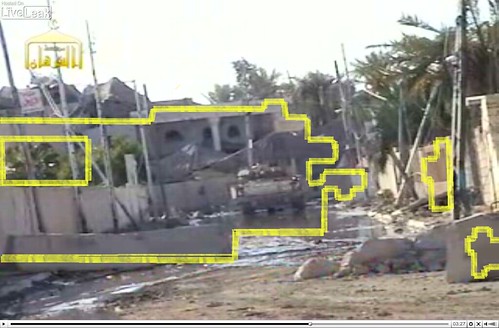
Conclusions
In the end it is fairly easy to convince oneself that the video has been manipulated with a clear intent to decieve the viewer. It's not just a matter of making it more exciting by looping the explosions and playing them in slow motion. Information that would allow the viewer to confirm the identities of objects presented has been removed, as has information that would establish the order of events. The manipulation is clumsy enough that it is easy to document places where information has been removed but, clumsy though it was, the manipulation does prevent us from knowing exactly what has been removed. We can only speculate. So we will.
My best guess is that the object shown in the video was at no time an in-service Bradley. There was something three-dimensional there, at least in the first sequence. The footage of the guy planting the bag of "explosives" and the can of fuel are very convincing. He clearly crawled under something that had tracks and cast a shadow. But, whatever it was, it seemed a bit big for a Bradley and there must have been something wrong with the tracks or they wouldn't have gone to the trouble of blurring them on each and every frame in which they appear. It could have been a bulldozer with a painted picture of a Bradley mounted in place of the blade (or on the back) or it could have been an old, decommissioned Bradley with the old-style tracks. One thing that argues that it was not any kind of a Bradley is that the chain gun is pointing exactly at the camera. The three-foot barrel appears as a circle with a dot in the middle. What are the odds of that happening by accident?
Why do you suppose the Bradley is sitting in the middle of a big puddle? Again, I know it rains in Iraq and there are muddy bits but it is also true that a puddle of standing water won't show footprints or tracks. In particular, as long as you used a hose to keep it topped up, a puddle would obscure the marks one would make while driving a tracked vehicle around the corner and setting up the canvas outline rigged with explosives to disappear in puff of smoke. Similarly, the puddle would also hide the marks you made lugging in your Bradley-shaped pile of wood and old tires and setting it on fire.
That's just my theory. Other interpritations are possible. Feel free to leave comments giving your theories.


